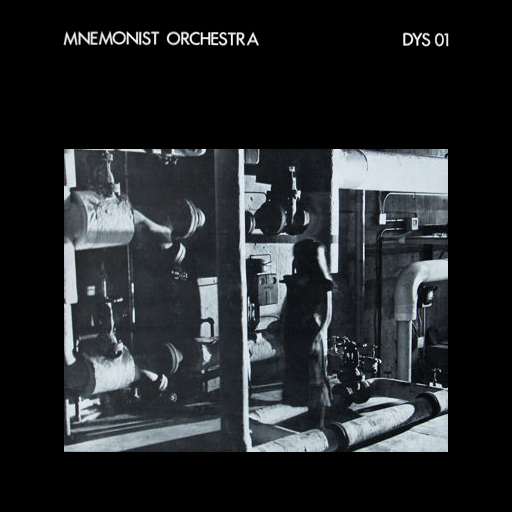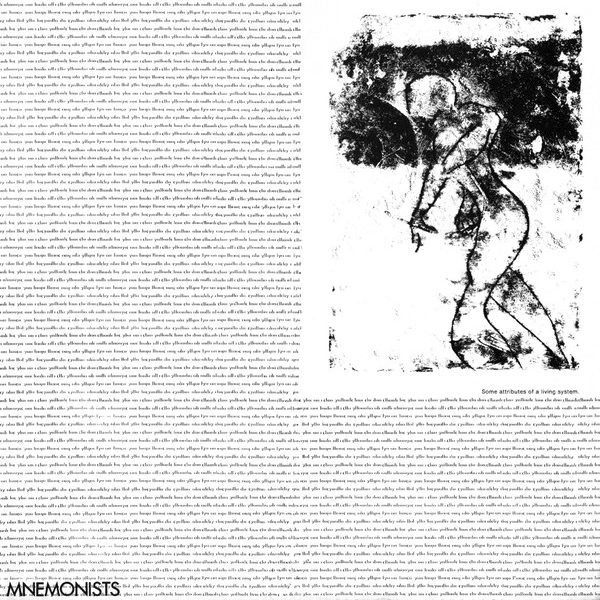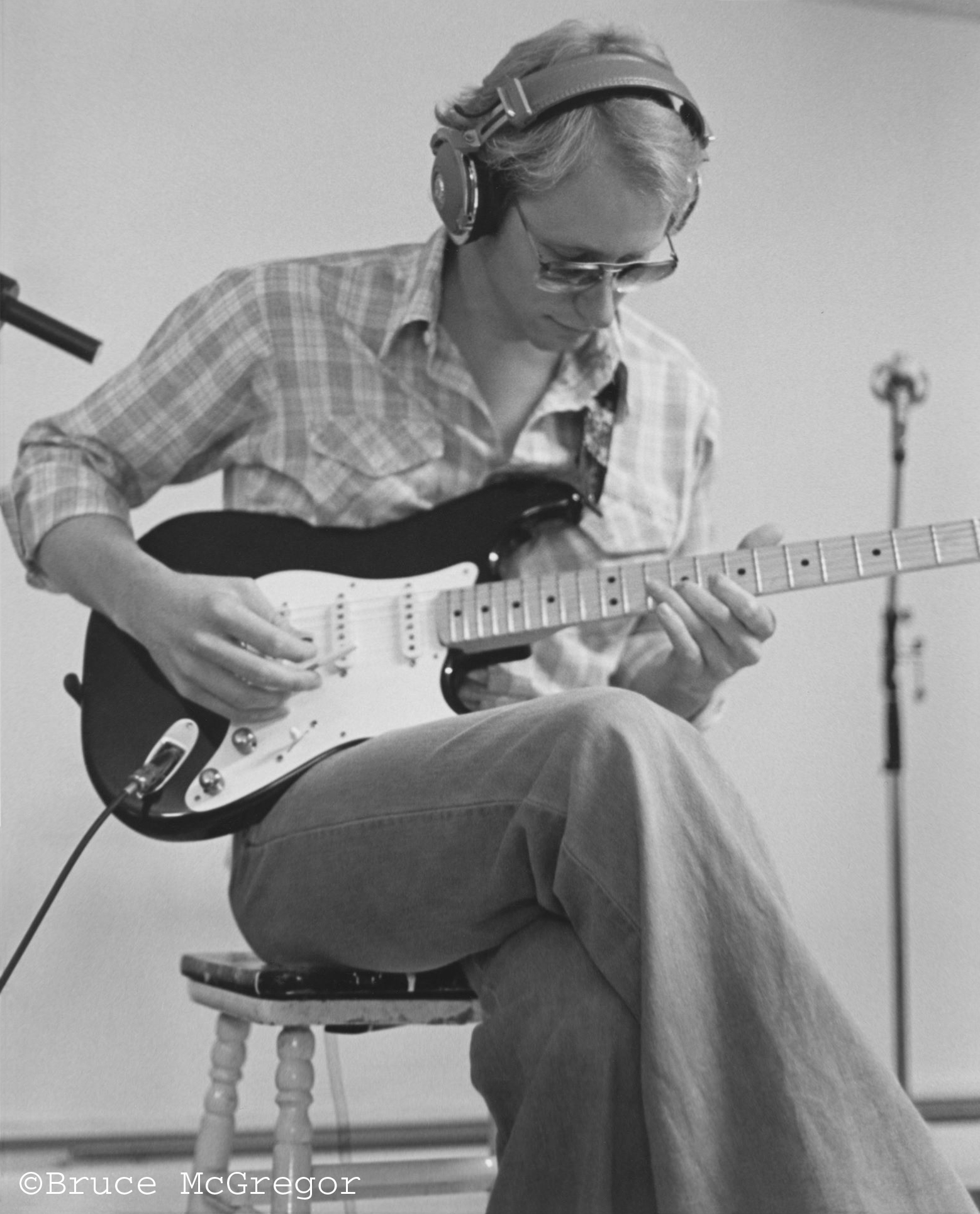Mnemonist Orchestra
John Herdt talks about playing guitar on the first two Mnemonist Orchestra albums.
Mnemonist Orchestra
By John Herdt
 In 1979 I played guitar on the first album by the Mnemonist Orchestra, titled Mnemonist Orchestra with the catalog number of Dys 01 on Dys Records. I actually need to try and find exactly when we did the single live recording session that resulted in the album. Producer and lead visionary Bill Sharp said in a later interview that the Mnemonist Orchestra came together in March 1979. It was released in 1979, but was likely recorded in the fall or winter of 1978 which gave Bill and Mark time to edit and arrange the album for a release in Spring 1979. I don’t remember it being cold though because I remember taking a break outside some of the other players, and I remember it being chilly but I don’t remember us wearing coats.
In 1979 I played guitar on the first album by the Mnemonist Orchestra, titled Mnemonist Orchestra with the catalog number of Dys 01 on Dys Records. I actually need to try and find exactly when we did the single live recording session that resulted in the album. Producer and lead visionary Bill Sharp said in a later interview that the Mnemonist Orchestra came together in March 1979. It was released in 1979, but was likely recorded in the fall or winter of 1978 which gave Bill and Mark time to edit and arrange the album for a release in Spring 1979. I don’t remember it being cold though because I remember taking a break outside some of the other players, and I remember it being chilly but I don’t remember us wearing coats.
I knew producer Bill Sharp while I lived in Corbett Hall from 1974-1976 at Colorado State University. Bill was not to my knowledge a musician while we lived on the same floor at Corbett, but he was always into music near was near the outside of the norm, and was later responsible for bringing avant-garde acts like Henry Kaiser to Fort Collins. Bill used to hear me practicing my guitar in my room and thought my playing was at least a little bit interesting. He didn’t hold mainstream bands like Mountain or Montrose in high regard, but at the time I was into the great rock bands and guitar gods but also into jazz-rock fusion, particularly stuff built around guitarist Tommy Bolin. I do remember Bill liking Supertramp.
When my final school year started in 1978 I was living with Dave Marsh and Steve Chaffey (bass in drums in our band the Head Arrangers) in a house on Elm Street. We used to through lots of parties at that house, where we would play at and have friends over to play. I wasn’t seeing Bill as often as I had a few years earlier, but he asked us if we wanted to play on an experimental project at the CSU radio station. We were big adventurers so we said hell yeah.
When we got to the radio station they had a number of other people involved in the session too, including Hugh Ragin, a world-class trumpet player and teacher in the CSU music program. Hugh had gained acclaim playing with people like free-jazz saxophone player Ornette Coleman. There were some other brass players from the CSU faculty, as well as percussionists and such.
The large band was split into two rooms where one half of the players couldn’t see or hear the other half. We were told that the plan was for everyone to play whatever they wanted, whether it went with what anyone else was playing or not. The idea was that Bill would just motion for us to take the dynamics up or down, play real loud or real quiet. Bill was in our room. In the other room as I remember was Mark Derbyshire, who I understood to be the engineer on the project, giving that room of people the same kinds of instructions.
I was the only guitarist playing in the live recording. I sat very close to Hugh Ragin and the rest of the brass. I remember trying to visualize a space in my head for what we were playing, and what I was thinking about was sitting on the balcony of an apartment at night in New York with a bunch of other noise going on as if from the neighborhood and the city itself. What I had in mind was the way New York looked in West Side Story, but with a darker vibe like the area the 50’s beat poets frequented.
I played my 1973 Fender Stratocaster into a Peavey Classic 50 combo amp. In retrospect parts of what I played were fairly satisfying, but listening to it today I would have gone for more ambient washes of sound and less solo blasting. At the time I had been playing guitar for about five years after having played sax in high school band, and the first thing I had gotten good at was playing leads with attitude. My band the Head Arrangers were jamming out hard at parties, keggers and frat house gigs, so we could throw down some pretty intense stuff, but my palette at the time was based on blasting the hell out of dorian mode solos. They acted like I was playing what they wanted as it was going down though.
In spite of my reservations the album was fairly well received in the avant-garde community, particularly in Italy. Bill had a record release party and I was going to go but my band and I had a separate celebration party beforehand and I felt like I was walking into a blizzard just trying to make it from my bathroom to my closet. Heck of a lot of fun but no way was I driving, and Dave and Steve had split earlier so I was on my own. I decided to walk the couple of miles to Bill’s. It was one of the most interesting walks of my life. I was excited about the album, and the streets were quiet and beautiful in the moonlight. BUT… I had decided to not wear my glasses so I would look prettier, and I walked about 10 miles in circles before I made it to Bill’s place, stopping every few blocks to squint at the street signs. As I walked up to his house people were walking out, including one guy with a guitar hanging down to his knees on a long strap, he was just walking around like that like it was a big necklace.
I had missed the whole party, including the playing of the whole album for the attendees. I went inside and the remaining people went “where were you???” I told them the truth of my wondrous journey walking across town. Bill turned me on to two copies of it and I decided to walk back home. The walk home was especially cool, having your first album under your arm will do that, especially knowing it had had some impact. On my way home I stopped at the post office and lay on my back on the nice lawn and looked at the stars with an LP in each hand.
To my ears the album wouldn’t appeal to mainstream listeners, but it found a niche and a Google search for Mnemonist Orchestra will bring up a lot of hits.
Some Attributes of a Living System
 I was asked also to play on the follow up album entitled Some Attributes of a Living System released in 1980 (DYS 02, Dys Records). The album was released as being by “Mnemonists” rather than “Mnemonist Orchestra,” but I don’t remember knowing that was going to happen at the time of the recording sessions. Some Attributes of a Living System was recorded and produced in an entirely different manner from Mnemonist Orchestra. Mark Derbyshire had some high end recording gear in his basement studio in Fort Collins, part of which was in his BOMB SHELTER (small concrete nuclear war survival room popular during the cold war). When we recorded it wasn’t as a large live band, but rather in small groups that would fit into the bomb shelter, except one funk groove that I played with bassist Mark Shulz and drummer Ken Lark (played on Zephyr’s Heartbeat LP), which we did in the larger open studio area. Once again I was matched with Hugh Ragin and we and a few other guys fit into the bomb shelter. I remember one exciting moment where the door of the bomb shelter was open and Hugh was standing out between two huge six foot tall flat monitor speakers and I unloaded a really burning solo and Hugh was bent over grimacing, really digging it. Jazz guys were digging rock guitarists who could play with them back then.
I was asked also to play on the follow up album entitled Some Attributes of a Living System released in 1980 (DYS 02, Dys Records). The album was released as being by “Mnemonists” rather than “Mnemonist Orchestra,” but I don’t remember knowing that was going to happen at the time of the recording sessions. Some Attributes of a Living System was recorded and produced in an entirely different manner from Mnemonist Orchestra. Mark Derbyshire had some high end recording gear in his basement studio in Fort Collins, part of which was in his BOMB SHELTER (small concrete nuclear war survival room popular during the cold war). When we recorded it wasn’t as a large live band, but rather in small groups that would fit into the bomb shelter, except one funk groove that I played with bassist Mark Shulz and drummer Ken Lark (played on Zephyr’s Heartbeat LP), which we did in the larger open studio area. Once again I was matched with Hugh Ragin and we and a few other guys fit into the bomb shelter. I remember one exciting moment where the door of the bomb shelter was open and Hugh was standing out between two huge six foot tall flat monitor speakers and I unloaded a really burning solo and Hugh was bent over grimacing, really digging it. Jazz guys were digging rock guitarists who could play with them back then.
The editing was as different from the first album as the recording process. Bill and Mark really cut up our performances and moved stuff around, and they also recorded a bunch of new parts, mainly voices but some instruments too. What they built was a mosaic of sounds that would be similar to a mosaic or impressionist painting, in that you have to open your perception to understand what the art of it is. I think that’s the key to what Bill and Mark were trying to achieve in with both albums, to communicate in a manner that was oblique and possibly alarming, but in the end opening up doors of perception that couldn’t be opened any other way.
Both of the first two albums ran out of print, but in 1984 they were re-printed and released as a double album. I’ve seen copies of the first album sell online for hundreds of dollars, which is pretty exciting. My own music is more melodic, but I try to let in at least the spirit of adventure that was employed on those albums. Bill and Mark went on to release a more albums they did totally by themselves under the band name “Mnemonists” and then most successfully as Biota.
JOHN HERDT AT MNEMONIST ORCHESTRA SESSION
On December 20, 2019 I got one of the coolest Christmas presents I could imagine. I hadn’t talked to Mnemonist Orchestra producer and mastermind Bill Sharp in decades and found him on Facebook. It wasn’t easy, for the degree of success he’s had with his albums over the years he seems almost reclusive online. I sent him a friend request and he immediately sent me this photo, which I did not know even existed.
At first glance I thought it was from the live session at the radio station for the first album, Mnemonist Orchestra, because there is so much room around me in the photo. Bill said, however, that it is from the sessions for the second album, Some Attributes of a Living System. That was a surprise, because that second album was recording in a bomb shelter where it felt like we were sitting shoulder to shoulder like in a steam room at a health club.
Thanks to Bill and to photographer Bruce McGregor, who also did engineering on the albums. It’s great to have a photo to help me remember the great experience of recording those two pieces of work.

